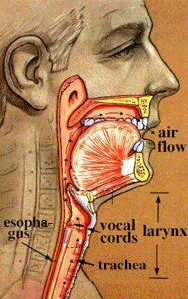What is a Laryngectomy?
A laryngectomy is surgical removal of the larynx, also called the voice box.
This diagram shows a cross sectional view of the normal throat and the larynx.  You can see that the larynx is located at the point where a division occurs from the single tube that makes up the throat (also called the pharynx) into a separate tube for food going to the stomach (the esophagus) and air going to the lungs (trachea, or windpipe). One important function of the larynx is to protect the airway by ensuring that swallowed foods and liquids pass down the esophagus instead of going into the lungs.
You can see that the larynx is located at the point where a division occurs from the single tube that makes up the throat (also called the pharynx) into a separate tube for food going to the stomach (the esophagus) and air going to the lungs (trachea, or windpipe). One important function of the larynx is to protect the airway by ensuring that swallowed foods and liquids pass down the esophagus instead of going into the lungs.
The vocal folds, responsible for sound generation in speech and singing, are also located in the larynx. As air is exhaled past the vocal folds, they vibrate and produce the sounds heard in voiced speech.
If the larynx is removed, air can no longer pass from the lungs into the mouth because the connection between the mouth and the windpipe no longer exists. In order to allow air to get into the lungs, an new opening must be made in the front of the neck. The upper portion of the trachea (windpipe) is brought out to the front of the neck to create a permanent opening called a stoma. When a laryngectomy patient inhales, air passes directly through the stoma into the trachea and then into the lungs. The connection between the mouth and the esophagus is usually not affected, so food and liquid can be swallowed just as they were before the operation. Removal of the vocal cords means that a laryngectomy patient will no longer have laryngeal speech. This does not mean that speech is lost, as there are ways to talk without a larynx.
The operation itself is done through an incision in the neck. A neck dissection is often done at the same time to remove lymph nodes in the neck that may be involved with cancer.
What to expect immediately after a laryngectomy
The first couple nights after a laryngectomy are usually spent in the intensive care unit (ICU) in a hospital. As with most other operations for head and neck cancer, the patient will have one or more suction drains under the skin to collect any small amount of fluid collection in the neck. The drains are removed after several days. There also will be intravenous lines (IVs) in order to give fluids and medicine.
While the lower portion of the throat is healing after a laryngectomy, the patient will not be able to swallow food or liquids. In order to supply nutrition, a small flexible plastic feeding tube will be usually placed into the stomach through the nose. If all goes well, the patient will be able to start swallowing about one week after the operation and the feeding tube can be removed at that time. If there is concern that a tube may be needed for a much longer time, it can be placed through the skin of the abdomen directly into the stomach. Placement of this tube, called a PEG, is more involved but it is easier to take care of and less conspicuous.
In some cases a tracheotomy tube is placed into the stoma after the operation. However, this is usually done on a temporary basis until the stoma can stay open on its own.
Total hospital stay after a laryngectomy is usually about a week. Some patients may not be quite ready to go home after they leave the hospital and will spend a few days at a nursing care center.
What to expect long-term after a laryngectomy
When we breathe, air normally passes through our nose or mouth and is both warmed and humidified before reaching the windpipe, or trachea. After a laryngectomy the air will instead pass directly into the windpipe through the stoma. As a result, the lining of the windpipe will be exposed to air that is much drier and cooler than usual. The mucous that normally lines the trachea will become thicker and crusting can develop. The crusts that form can actually block the airway and can also lead to infection.
In order to prevent this, a small mask with humidified air will be placed over the stoma. The patient will need to use this mask as much as possible until the lining of the windpipe matures and can tolerate the drier air.
Misted air, as well as cleaning and suctioning of the stoma, are essential for the health of the patient. Some patients may develop crusting around the stoma which needs to be cleaned away. The trachea itself may also need suctioning. It is important that the patient as well as family and friends become familiar with stomal care. As the stoma is the patient's only airway, any blockage can be very serious. With proper care, these blockages are very rare.
